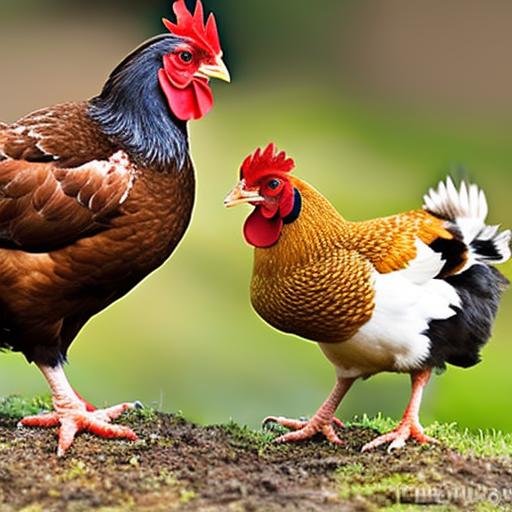Keeping chickens has become a popular hobby for many people, whether they live in rural areas or urban settings. Chickens not only provide fresh eggs but also make great pets and can help control pests in the garden. One question that often arises for chicken keepers is whether it’s possible to keep different breeds of chickens together. The answer is yes, but there are some things to consider before mixing breeds in your flock.
Key Takeaways
- Keeping different breeds of chickens together can be beneficial for both the chickens and the owner.
- Factors to consider before keeping different breeds of chickens together include breed compatibility, space requirements, and egg production.
- Choosing the right breeds to keep together involves researching their temperament, size, and egg-laying abilities.
- Housing requirements for different breeds of chickens vary based on their size, activity level, and climate.
- Planning, designing, building, and maintaining a well-designed chicken coop is essential for keeping multiple breeds of chickens together.
Benefits of Keeping Different Breeds of Chickens Together
There are several benefits to keeping different breeds of chickens together. One of the main advantages is increased egg production. By having a variety of breeds, you can have chickens that lay eggs of different sizes, colors, and flavors. This can add excitement and variety to your daily egg collection.
Another benefit is better pest control. Different breeds have different foraging habits, which means they will eat a wider range of insects and pests in your garden. This can help keep your plants healthy and reduce the need for chemical pesticides.
Having different breeds also adds visual interest to your flock. Imagine a coop filled with chickens of various colors, patterns, and sizes. It’s like having a living work of art in your backyard.
Factors to Consider Before Keeping Different Breeds of Chickens Together
Before mixing different breeds in your flock, there are several factors to consider. One important factor is breed temperament. Some breeds are more docile and friendly, while others can be more aggressive or flighty. It’s important to choose breeds that will get along well with each other to prevent any conflicts or injuries.
Size is another factor to consider. Some breeds are larger and more dominant, while others are smaller and more submissive. It’s important to choose breeds that are similar in size to prevent any bullying or aggression within the flock.
Egg-laying habits should also be taken into account. Some breeds are known for their prolific egg-laying, while others may be more sporadic. If you’re looking for a consistent supply of eggs, it’s important to choose breeds that have similar egg-laying habits.
Choosing the Right Breeds to Keep Together
When choosing breeds to keep together, it’s important to select ones that have similar temperaments and egg-laying habits. This will help ensure harmony within the flock and prevent any conflicts or disruptions in egg production.
It’s also important to consider the size of the breeds and how they will interact with each other. Mixing large and small breeds can lead to bullying or injuries, so it’s best to choose breeds that are similar in size.
Researching each breed before adding them to your flock is crucial. Look for information on breed temperament, size, and egg-laying habits to make an informed decision.
Housing Requirements for Different Breeds of Chickens
Different breeds of chickens have different housing requirements. It’s important to provide enough space for each breed to prevent overcrowding and stress.
The amount of space needed will depend on the size of the breed. Larger breeds will require more space than smaller ones. As a general rule, each chicken should have at least 4 square feet of indoor space and 10 square feet of outdoor space.
The type of coop you choose will also depend on the breed. Some breeds are more cold-hardy and can tolerate colder temperatures, while others may require additional insulation or heating during the winter months.
Planning Your Chicken Coop for Multiple Breeds

When planning your chicken coop for multiple breeds, it’s important to consider the needs of each breed. This includes their size, temperament, and egg-laying habits.
Decide on the size and layout of the coop based on the number and size of chickens you plan to keep. Make sure there is enough space for each breed to move around comfortably and access food and water.
Consider the temperament of each breed when planning the layout. Some breeds may prefer to roost higher than others, so make sure to provide enough perches at different heights.
Designing Your Chicken Coop for Multiple Breeds
Designing your chicken coop for multiple breeds involves adding nesting boxes and perches that accommodate the needs of each breed.
Provide enough nesting boxes for each breed to lay their eggs. The general rule is one nesting box for every 3-4 hens. Make sure the nesting boxes are easily accessible and provide privacy for the hens.
Add perches at different heights to accommodate the preferences of each breed. Some breeds may prefer to roost higher, while others may prefer lower perches. Providing a variety of options will ensure that each breed is comfortable.
Building Your Chicken Coop for Multiple Breeds
When building your chicken coop for multiple breeds, it’s important to choose the right materials and tools. The coop should be sturdy, predator-proof, and well-ventilated.
Choose materials that are durable and easy to clean. Consider using hardware cloth or welded wire mesh to prevent predators from entering the coop.
Follow safety guidelines and building codes when constructing the coop. Make sure there are no sharp edges or protruding nails that could injure the chickens.
Maintaining Your Chicken Coop for Multiple Breeds
Maintaining your chicken coop for multiple breeds involves regular cleaning and disinfecting to prevent the spread of disease.
Clean out the coop regularly to remove droppings and soiled bedding. This will help prevent the buildup of ammonia and reduce the risk of respiratory issues in the chickens.
Disinfect the coop periodically using a poultry-safe disinfectant. This will help kill any bacteria or parasites that may be present in the coop.
Monitor the health of each breed and address any issues promptly. Look for signs of illness or injury, such as lethargy, loss of appetite, or abnormal behavior. Consult a veterinarian if you notice any concerns.
The Benefits of Keeping Different Breeds of Chickens Together in a Well-Designed Chicken Coop.
In conclusion, keeping different breeds of chickens together can be a rewarding experience. It offers benefits such as increased egg production, better pest control, and visual interest in your flock.
Before mixing breeds, it’s important to consider factors such as breed temperament, size, and egg-laying habits. Choose breeds that are compatible with each other to ensure harmony within the flock.
When planning and designing your chicken coop, consider the needs of each breed. Provide enough space, nesting boxes, and perches to accommodate the different breeds.
Maintain the coop regularly by cleaning and disinfecting to prevent the spread of disease. Monitor the health of each breed and address any issues promptly.
With careful research and planning, you can create a well-designed chicken coop that allows different breeds to live together harmoniously and thrive.
If you’re interested in keeping different breeds of chickens together, you may also find this article on poultrywizard.com about creating the perfect farmhouse chicken coop helpful. It provides valuable insights and tips on how to design a coop that accommodates multiple breeds, ensuring their comfort and well-being. Check it out here.
FAQs
What is the best way to keep different breeds of chickens together?
The best way to keep different breeds of chickens together is to ensure that they have enough space, food, and water. It is also important to monitor their behavior and health regularly.
Can different breeds of chickens live together peacefully?
Yes, different breeds of chickens can live together peacefully if they are introduced properly and have enough space. However, some breeds may be more aggressive than others, so it is important to monitor their behavior.
What are the benefits of keeping different breeds of chickens together?
Keeping different breeds of chickens together can provide a more diverse and interesting flock. It can also help with pest control and provide a wider range of egg colors and sizes.
What are the risks of keeping different breeds of chickens together?
The risks of keeping different breeds of chickens together include the spread of diseases and parasites, as well as the potential for aggressive behavior and bullying. It is important to monitor the flock regularly and separate any birds that show signs of illness or aggression.
How do I introduce new breeds of chickens to my existing flock?
To introduce new breeds of chickens to an existing flock, it is best to keep them separated for a few weeks to ensure that they are healthy and free from any diseases. Then, gradually introduce them to the flock, starting with short supervised visits and gradually increasing the amount of time they spend together.
Meet Walter, the feathered-friend fanatic of Florida! Nestled in the sunshine state, Walter struts through life with his feathered companions, clucking his way to happiness. With a coop that’s fancier than a five-star hotel, he’s the Don Juan of the chicken world. When he’s not teaching his hens to do the cha-cha, you’ll find him in a heated debate with his prized rooster, Sir Clucks-a-Lot. Walter’s poultry passion is no yolk; he’s the sunny-side-up guy you never knew you needed in your flock of friends!







